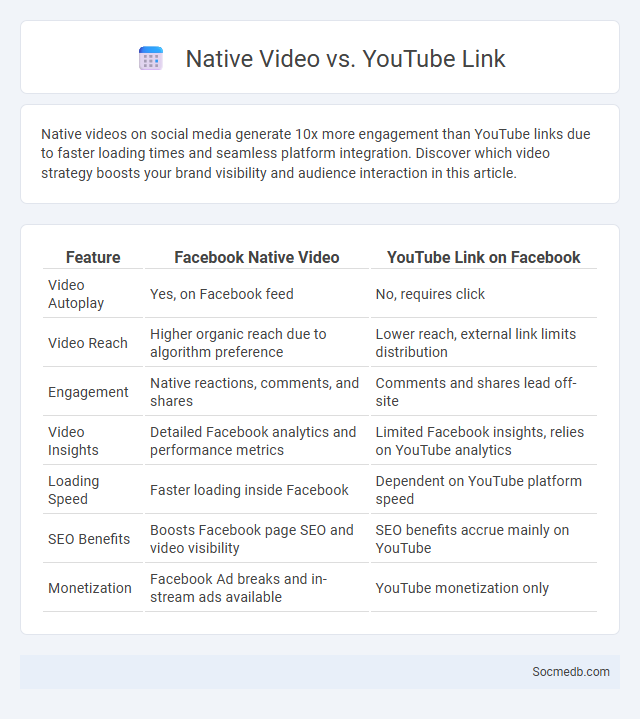
Photo illustration: Native Video vs YouTube Link
Native videos on social media generate 10x more engagement than YouTube links due to faster loading times and seamless platform integration. Discover which video strategy boosts your brand visibility and audience interaction in this article.
Table of Comparison
| Feature | Facebook Native Video | YouTube Link on Facebook |
|---|---|---|
| Video Autoplay | Yes, on Facebook feed | No, requires click |
| Video Reach | Higher organic reach due to algorithm preference | Lower reach, external link limits distribution |
| Engagement | Native reactions, comments, and shares | Comments and shares lead off-site |
| Video Insights | Detailed Facebook analytics and performance metrics | Limited Facebook insights, relies on YouTube analytics |
| Loading Speed | Faster loading inside Facebook | Dependent on YouTube platform speed |
| SEO Benefits | Boosts Facebook page SEO and video visibility | SEO benefits accrue mainly on YouTube |
| Monetization | Facebook Ad breaks and in-stream ads available | YouTube monetization only |
Introduction: Understanding the Digital Video Landscape
Digital video has become the dominant form of content on social media platforms, driving user engagement and shaping online interactions. Platforms like YouTube, Instagram, TikTok, and Facebook prioritize video formats including short stories, live streams, and reels, maximizing reach and retention rates. Understanding the algorithms and viewer behaviors that influence video distribution is essential for brands and creators aiming to optimize visibility and impact in this competitive digital landscape.
What Is Native Video?
Native video refers to video content that is uploaded directly to a social media platform, such as Facebook, Instagram, or Twitter, rather than shared via external links like YouTube or Vimeo. These videos are optimized for the specific platform's format, enhancing user engagement through features like autoplay, captions, and mobile-friendly display. Native videos often achieve higher reach and interaction rates due to their seamless integration within the social media environment.
YouTube Link Sharing Explained
YouTube link sharing allows users to distribute video content across various platforms, enhancing reach and engagement. By copying the URL directly from the video's address bar or using the 'Share' button, users can effortlessly share content via email, social networks, or messaging apps. Embedding YouTube links in websites or blogs increases video visibility, driving traffic and boosting search engine optimization (SEO).
Defining Viral Content in 2024
Viral content in 2024 thrives on authentic storytelling, visually engaging formats, and real-time relevance across platforms like TikTok, Instagram, and Twitter. Your content's potential to spark emotional reactions and encourage user interaction significantly amplifies its reach through algorithm-driven sharing. Understanding these dynamics helps you create posts that capture widespread attention quickly and sustainably.
Engagement Metrics: Native Video vs YouTube Link
Engagement metrics for native video content on social media often outperform YouTube links, as native videos autoplay and keep users within the platform, increasing watch time and interaction rates. YouTube links tend to drive external traffic but usually result in lower immediate engagement, such as likes, comments, and shares, compared to videos uploaded directly. Optimizing your posts with native video enhances visibility and maximizes your social media performance by leveraging platform algorithms that favor in-app content.
Algorithm Reach: Platform Preferences for Video Formats
Social media algorithms prioritize video formats based on platform-specific user engagement patterns, such as Instagram favoring short-form Reels and TikTok promoting vertical videos under 60 seconds. Facebook's algorithm boosts live videos and longer content that encourages comments and shares, while YouTube emphasizes watch time and consistency in video uploads. Understanding these platform preferences helps marketers maximize reach by tailoring video length, style, and format to each algorithm's nuances.
User Experience and Accessibility
Social media platforms prioritize user experience by implementing intuitive interfaces and personalized content algorithms that enhance engagement and satisfaction. Accessibility features such as screen reader compatibility, keyboard navigation, and adjustable text sizes ensure inclusivity for users with disabilities. Continuous improvements in UI design and compliance with WCAG standards significantly contribute to a seamless and equitable digital environment.
Brand Visibility and Trust
Effective social media strategies significantly enhance brand visibility by increasing reach and engagement across diverse platforms such as Instagram, Facebook, and LinkedIn. Consistent posting, influencer partnerships, and targeted advertising boost brand recognition and attract a loyal audience, improving overall market presence. Trust is established through transparent communication, authentic content, and responsive customer interactions, fostering consumer confidence and long-term brand loyalty.
Content Optimization Strategies
Effective content optimization strategies for social media include leveraging keyword research to align posts with trending topics and audience interests, boosting visibility and engagement. Utilizing metadata such as captions, hashtags, and alt text enhances searchability and accessibility across platforms like Instagram, Facebook, and Twitter. Analyzing performance metrics and adapting content formats based on user interaction data ensures continuous improvement and relevance in social media campaigns.
Conclusion: Choosing the Best Format for Your Goals
Selecting the right social media format hinges on your specific goals, whether aiming to boost engagement, build brand awareness, or drive conversions. Video content often yields the highest engagement rates, while images and infographics excel in conveying complex information quickly. Understanding your target audience's preferences ensures your content delivers maximum impact and achieves your desired outcomes.
 socmedb.com
socmedb.com